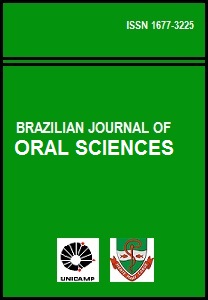Abstract
This research evaluated two techniques to record the occlusal contacts in habitual maximal intercuspation obtained in models mounted in semi adjustable articulator and in the mouth using an eight-micrometer carbon paper and sensors (T-Scan II). It was selected a sample of twenty five people, male and female, ages between twenty and twenty five years old with natural dentition. The collected data were visually and statistically evaluated by means of the Spearman coefficient. The results showed that the carbon paper as material used for the occlusal contact records enabled to determine exactly the quantity and its locations in the occlusal surface. However, it did not provide the information on the sequence, time and intensity on how these occur. The T-Scan system enabled to determine the quantity, the sequence and the exact time that they occur, however the system did not determine the exact location of the contacts over the teeth occlusal surface. It was observed that in both methods, the quantity of the occlusal contacts recorded in the mouth was higher than the ones obtained in the articulator and that the sensor thickness did not interfere in the reproduction of the quantity of dental contacts in comparison to the carbon paper.
References
Bessette RW, Bishop B, Mohl N. Duration of masseteric silent period in patients with TMJ syndrome. J Appl Physiol. 1971; 30: 864-9.
Bessette RW, Shatking SS. Predicting by electromyography the results of nonsurgical treatment of temporomandibular joint syndrome. Plastic Reconstr Surg. 1979; 64: 232-8.
Ferrario VF, Serrao G, Dellavia C, Caruso E, Sforza C. Relationship between the number of occlusal contacts and masticatory muscle activity in healthy young adults. Cranio. 2002; 20: 91-8.
Gazit E, Fitzig S, Lieberman MA. Reproducibility of occlusal marking techniques. J Prosthet Dent. 1986; 55: 505-9.
Makofsky HW. The effect of head posture on muscle contact position. The sliding cranium theory. Cranio. 1989; 7: 286-92.
Mohlin B, Ingervall B, Thilander B. Relation between malocclusion and mandibular dysfunction in Swedish men. Eur J Orthod. 1980; 2: 229-38.
Muhleman HR, Savdir S, Rateitschak KH. Tooth mobility-its causes and significance. J Periodontol. 1965; 36: 148-53.
Petit H. L’Occlusogramme- Objectivation des troubles occlusaux. Actual Odontostomatol (Paris). 1967; 77: 37-59.
Walls AWG, Wassel RW, Steele JG. A comparison of two methods for locating the intercuspal position (ICP) whilst mounting casts on an articulator. J Oral Rehabil. 1991; 18: 43-8.
Breitner C. Bone changes resulting from experimental orthodontic treatment. Amer J Orthod ORal Surg 1940; 26: 251-4.
Hillam DG. Stresses in the periodontal ligament. J Periodont Res. 1973; 8: 51-6.
Wright PS. Image analysis and occlusion. J Prosthet Dent. 1992; 68: 487- 91.
Yurkstas A, Manly RS. Measurement of occlusal contact area effective in mastication. Am J Orthod. 1949; 35: 185-8.
Beyron H. Occlusal relations and mastication in Australian aborigines. Acta Odontol Scand. 1964; 22: 597-678.
Randow K, Carlsson K, Edlund J, Oberg T. The effect of an occlusal interference on the masticatory system. An experimental investigation. Odontol Revy. 1976; 27: 245-56.
Watt DM. Recording the sounds of tooth contact: a diagnostic technique for evaluation of occlusal disturbances. Int Dent J. 1969; 19: 221-38.
Aoki H, Shimizu T, Shimizu Y, Yoshino R. Clinical evaluation of the occlusion of natural dentitions by means of a semiadjustable articulator. Bull Tokyo Dent Coll. 1970; 11: 211-21.
Dawson PE, Arcan M. Attaining harmonic occlusion through visualized strain analysis. J Prosthet Dent. 1981; 46: 615-22.
Ziebert GJ, Donegan SJ. Tooth contacts and stability before and after occlusal adjustment. J Prosthet Dent. 1979; 42: 276-81.
DeBoever J. Experimental occlusal balancing contact interference and muscle activity. Paradentologie. 1969; 23: 59-61.
Millstein PL. A method to determine occlusal contact and noncontact areas : Preliminary report. J Prosthet Dent. 1984; 52: 106-10.
Maness WL. Laboratory comparison of three occlusal registration methods for identification of induced interceptive contacts. J Prosthet Dent. 1991; 65: 483-7.
Riise C, Sheikholeslam A. The influence of experimental interfering occlusal contacts on the postural activity of the anterior temporal and masseter muscles in young adults. J Oral Rehabil. 1982; 9: 419-25.
Halperin GC, Halperin AR, Norling BK. Thickness, strength and plastic deformation of occlusal registration strips. J Prosthet Dent. 1982; 48: 575-8.
Hsu M, Palla S, Gallo LM. Sensitivity and reliability of the TScan system for occlusal analysis. J Craniomandib Disord. 1992; 6: 17-23.
Kifune R, Honma S, Hara K. The development of a new occlusal sound checker.
Nippon Shishubyo Gakkai Kaishi. 1985; 27: 482-91.
Korioth TWP. Number and location of occlusal contacts in intercuspal position. J 29. Prosthet Dent. 1990; 64: 206-10.
Millstein PL, Maya A. An evaluation of occlusal contact marking indicators. A descriptive quantitative method. J Am Dent Assoc. 2001; 132: 1280-6.
Moini RM, Neff PA. Reproducibility of occlusal contacts utilizing a computerized instrument. Quintessence Int. 1991; 22: 357-60.
Mongini F. Remodeling of the mandibular condyle in the adult and in relationship to the condition of the dental arches. Acta Anat. 1982, 82: 437-53.
Mongini F. Factors of occlusion applicable to restorative dentistry. J Prosthet Dent. 1953; 3: 772-82.
Seligman DA, Pullinger AG. Association of occlusal variables among refined TM patient diagnostic groups. J Craniomandib Disord. 1988; 3: 227-36.
Lauritzen AG. Atlas de analisis occlusal. Madrid: Martinez de Murguia; 1977. 67p.
Kirveskari PA, Jamsa T. Association between craniomandibular disorders and occlusal interferences in children. J Prosthet. Dent. 1992; 67: 692-6.
Millstein PL. An evaluation of occlusal contact marking indicators: a descriptive qualitative method. Quintessence Int. 1983; 14: 813-36.
Carossa S, Lajocono A, Schierano G, Pera P. Evaluation of occlusal contact in the dental laboratory: influence of strip thickness and operator experience. Int J Prosthodont. 2000; 13: 201-4
The Brazilian Journal of Oral Sciences uses the Creative Commons license (CC), thus preserving the integrity of the articles in an open access environment.


